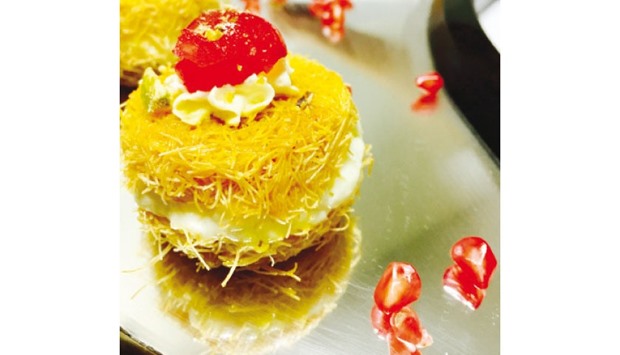Yes you read it right: kunafeh in the form of pie. I always try and modify classical dishes and present them in a unique way — this is one such example.
A few days back while I was driving past my favourite sweet shop in Doha, I stopped by to relish my favourite sweet dish — the kunafeh, the evergreen sweet that I can relish every single day.
The kunafeh I tried that day was the crispier one as opposed to the grounded kunafeh dough variety. I noticed that this delicate Arabian sweet dish is always prepared in large aluminium trays, and a portion is usually sliced out of the big platter and served with drizzle of sugar syrup.
I decided to make it in smaller pastry moulds and serve it individually portioned to make it even more special and elegantly presented. A pie is defined as stuffed sweet pastry, so I call my kunafeh as pie as the filling is sandwiched between two layers of kunafeh dough.
Kunafeh is an Arabic pastry made with spun whet strands or powder and is first baked and then soaked with sugar syrup. The kunafeh is considered to have originated in the city of Nablus in Palestine but is famous now across the world and especially Middle East for its great taste and texture. There are numerous recipe and variants of this dessert and method of preparation.
The city of Nablus in Palestine is especially renowned for its kunafeh. The city also holds the Guinness book world record for making the largest kunafeh in the world. The massive preparation weighed more than 1,350 kilograms and spanned over 75 X 2 metres. Although there are some popular variations to this dessert from neighbouring countries like Turkey, Jordan, Syria and Lebanon, the best one hails from Palestine.
One important aspect of associating any food dish with a place is that the area, demographic conditions, the climate of the region, the origin of water used in the preparation plays a very important role in achieving a specific taste of the food items and I have experienced it myself. For example, you can’t match the taste and texture of sponge rasgulla made in Kolkata, the originating place of the dessert as even the change in water used in its preparation makes it taste different than the one from Kolkata.
One popular story associated with the origin of kunafeh and its significance during Ramadan is about a princess who had difficulty in fasting because of her appetite. Her chef created this rich dish and asked her to eat ample quantity of the dessert before dawn so that she will not feel hungry during the day. After consuming kunafeh she could fast easily and thus this dish became associated with Ramadan.
Kunafeh pastry comes in three types, based on the texture of the dough used to make it. First is the rough one in which the crust is made with long thin noodle threads of spun wheat, the one I recently tried. The second type has a fine texture, where the dough is made with grounded spun wheat. The third and last type is a combination of the first two. My personal favourite now is the first one. In different variations of this dish, the kishta (clotted cream with rose water) is replaced by mozzarella or by cream cheese and at times cinnamon is also added.
Kunafeh Pie
Ingredients
Serves 4
Kunafeh dough 400 gm
Desi ghee 200 gm
For Kishta
Milk powder 150 gm
Water 500 gm
Semolina 50 gm
Corn flour 120 gm
For sugar syrup
Sugar 500 gm
Water 500 gm
Rose water few drops
For Garnish
Pistachio 50 gm
Cherry 50 gm
Method
Grease a muffins baking tray with desi ghee and spread a layer of half of the kunafeh dough strands.
Keep another muffins baking tray on the dough and place some heavy weight on top to flatten the dough and shape it.
In the meanwhile, make kishta by boiling water with milk powder.
Bring to boil and gradually add corn flour while whisking continuously till the mixture becomes sticky, add few drops of rose water.
Allow kishta to cool down and using a piping bag spread an even layer of kishta on kunafeh dough.
Layer the remaining kunafeh dough on top of kishta and press again using another muffin baking tray and heavy height.
Leave aside to set for 1 hour and remove the top tray and spread the remaining desi ghee on top.
Bake in a pre-heated oven for 25-30 minutes at 200 degree Celsius.
Make a thick sugar syrup by boiling together sugar and water and add rose water to flavour it.
Once the top layer has a nice golden colour remove from oven and pour the prepared sugar syrup as required.
Garnish with cherry and pistachio and serve hot.
Note: Fresh or frozen kunafeh dough is available readymade in local hypermarkets. Also you can try your own variation by adding nuts of your choice to the filling. Drizzle your kunafeh with exotic fruit purees like blueberry, cherry or cranberry to make your own preferred fruity kunafeh.

Kunafeh Pie. Photo by the author


